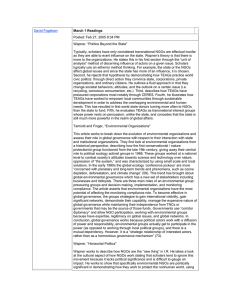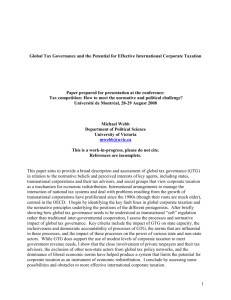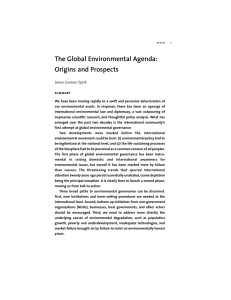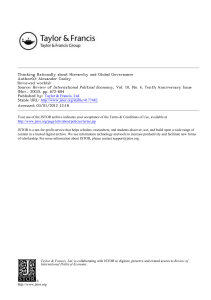The World Health Organization: Some Governance
advertisement
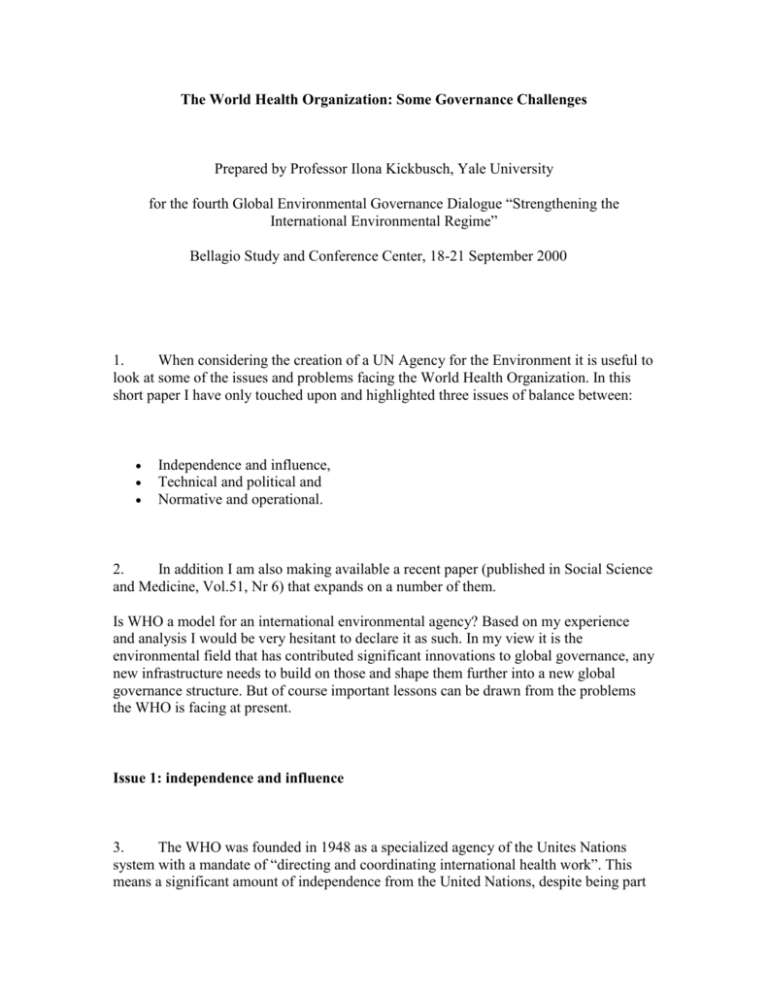
The World Health Organization: Some Governance Challenges Prepared by Professor Ilona Kickbusch, Yale University for the fourth Global Environmental Governance Dialogue “Strengthening the International Environmental Regime” Bellagio Study and Conference Center, 18-21 September 2000 1. When considering the creation of a UN Agency for the Environment it is useful to look at some of the issues and problems facing the World Health Organization. In this short paper I have only touched upon and highlighted three issues of balance between: Independence and influence, Technical and political and Normative and operational. 2. In addition I am also making available a recent paper (published in Social Science and Medicine, Vol.51, Nr 6) that expands on a number of them. Is WHO a model for an international environmental agency? Based on my experience and analysis I would be very hesitant to declare it as such. In my view it is the environmental field that has contributed significant innovations to global governance, any new infrastructure needs to build on those and shape them further into a new global governance structure. But of course important lessons can be drawn from the problems the WHO is facing at present. Issue 1: independence and influence 3. The WHO was founded in 1948 as a specialized agency of the Unites Nations system with a mandate of “directing and coordinating international health work”. This means a significant amount of independence from the United Nations, despite being part of the family. Member States elect the Director General of the organization on the recommendation of its Executive Board. The WHO has its own budget and sets its own program priorities. It has six regional offices, which in turn elect regional directors. They have a significant amount of independence, which has led analysts to talk of 7 WHOs. It has a very small regular budget (roughly US$ 800 000million for two years) and is highly dependent on voluntary donations (at present also about US$ 800 000). Its budget has been decreasing over the last 15 years. 4. Most of its resources are sent on staff and production of knowledge, which is appropriate for a knowledge organization, but is questioned at regular intervals (see below). Both for regular and VD budget it is dependent on a small number of member states. The USA contributes the highest percentage of the budget but is constantly in arrears. In comparison: World Bank lending in health is around 2 billion US$ a year. WHO has a system of linking to others through a process that nominates NGOs formally as “being in official relationships with WHO” as well as a process that designates research institutions in countries as collaborating centres, and has a joint policy body with UNICEF and UNFPA. It has an observer role in some other organizations, but no organized voice and no veto. It is frequently not consulted when other agencies embark on health programs. 5. Despite all the rhetoric about “a strong WHO” is highly probable that those member states who are the main financial contributors very consciously keep the organization on a tight leash as they are only willing to pool very small sections of their national sovereignty on health and want to continue to define the agenda of the organization, despite the voting majority of developing countries in the World Health Assembly. At present this agenda is very focused on infectious diseases. This has led to a reinvigoration of interest in surveillance, vaccines and vertical eradication programs. Analysts differ as to how much of this agenda is due to global solidarity, enlightened selfinterest or plain fear. 6. The coordination function of the social challenges in the world system and the independent agencies originally envisaged through ECOSOC has not materialized. The role of the ACC is also limited. While its constitution assigned WHO the coordinating role on health in the international system, this role has not been respected and accepted by other agencies who have entered the health arena (UNICEF, UNDP, The World Bank, European Union) nor the bilateral donors, particularly in recent years. The most obvious outcome of conflicts around leadership and coordination has been the creation of UNAIDS. 7. The number of actors in the international arena has become myriad and led to a significant shift of power, most recently through the creation of the Bill and Melinda Gates Foundation, that commands more resources for health than the regular budget of WHO. Partnership and networks rather than leadership has become the new mantra in the global arena. Questions: Elected or appointed head o Regional/ decentralized structure o Level and security of budget, balance between contributors o Relationship between regions and HQ o Relationship to UN system, new bodies at global and regional level (WTO/EU) o Power balance between developed and developing countries o One country one vote/weighted voting o Adequacy of nation states representation. o Network governance Issue 2: the normative and the operational 8. The creation of WHO was based on the experiences gained with the international health organizations that had existed before; indeed health was one of the first areas of structured international cooperation. In 1897 the nation states attending the International Sanitary Conference acknowledged the need for international health surveillance. In 1902 the Pan American Health Office was established, it now also acts as a regional office of WHO. In 1903 countries adopted the international sanitary convention, which called for the creation of an international organization and in 1907 the Organization International d’ Hygiene Publique (OIHP) was established in Paris. Later the League of Nations established a health office. The focus of this cooperation between sovereign nation states initially was disease surveillance with a view to trade embargos and military ventures. 9. In contrast to the earlier health organizations WHO in its constitution was given a very wide ranging mandate covering 22 functions based on a very wide definition of health. While this in principle gives the organization the flexibility to respond to changing contexts and priorities it has in reality led to a constant over expectation (both from Member States and the broader public) and a constant debate as to which functions should be prioritized. In the forefront is the discussion between the normative/standard setting role and the operational role. At the time of it’s founding no elaborate health systems existed at country level. Most of the developing world was part of the colonial system. A certain optimism prevailed: recent advances in medical science made it seem probable that many major diseases could be controlled, or even eradicated. 10. WHO embarked successfully on the eradication of small pox but failed with other diseases. It shifted its view from vertical programs to health systems needed in developing countries as they emerged as independent countries in the seventies. It set global health goals and attempted to establish a voluntary accountability system (Health for All by the Year 2000). But as the number of countries grew as well as the number of actors in international health, as the push for privatization pressed ahead, the economic stakes got ever higher and were linked to certain treatments and modes of intervention, as the disease spectrum changed and more attention was paid to determinants of health and disease, the WHO’s leadership and governing structure were not able to respond. Too much was being asked of the organization by too diverse a clientele. 11. Originally WHO was to pool the professional medical knowledge and make it available to all member states, also at the country level? It established country offices (with the exception of the developed countries who claimed they did not need WHO presence and advice), which were to be placed in ministries of health and to advise the minister and the staff. Initially most of these advisors came from developed countries and advised the newly created ministries in the newly independent states. But as the developing countries became more and more dependent on development aid in health WHO became less interesting as a partner, since it had no money to distribute for operational program. Also expertise was growing in the developing nations as the first generations who had studied abroad took power, now it seems that often the local staff is more expert than the WHO representative. Increasing health expertise was to be found with other organizations, donors, NGOs and the private sector – and the countries made good use of these organizations and their resources, often playing them against one another. Questions: Broad or narrow mandate Mechanisms of setting priorities (us/them) Core and support functions Leverage power to ensure coordination between agencies and the many actors Country presence/ operational role Vertical/horizontal subsidiarity Issue 3: the technical and the political 12. Increasingly decision making in the organization has moved from the purely technical to the political. While initially the election of the Director General was in essence a technical choice (reflecting the notion of medicine as an independent profession) made “from their midst” by the members of the Executive Board, who served in their personal capacity as health experts, it has (since the mid 1980ties) become highly politicized. A recent change of the constitution now has the EB representatives formally as representatives of countries thus acknowledging the interplay of the political and technical agendas. 13. Initially the cooperation with countries was structured around the key national public health agencies and research institutions. The aim was to keep the professionals and bureaucrats running these systems in touch with the most advanced health expertise order to ensure standards, continuity and professional excellence. This was initially a relatively small group of closely networked people, many of them trained in the same institutions and following a similar value system. A health became more important and visible at country level (ministries were established, increasing amounts of GNP were spent, health issues were linked to economic issues etc.) and more diverse in the international arena there was a power shift from the professional to the political. With the end of colonialism health became an important dimension of international foreign aid and of increasing high economic relevance (pharmaceutical industries) as well as of expanding NGO activities. The recommendations and standards proposed by the WHO gained new significance in this new context and frequently the health representatives in the governing bodies had to represent the view of interests other than health. At first instance WHO responded to these changes with creating a global health consensus around “primary health care” but could not sustain this leadership role in the long run, last not least because this approach ran counter to the growing neo liberalism that began to dominate development policies. 14. The organization itself reached out to organizations other than health, political decision makers (health ministers despite their very high turnover rate) and set as its goal to influence sectors other than health. The ensuing conflict between vertical and horizontal programs (focus on diseases or health determinants such as poverty) remains to this day. As more and more UN agencies, bi lateral bodies, NGOs and finally the Bretton Woods institutions took on health, the organization lost power and influence. While there is a plethora of working groups, joint committees, alliances, and negotiations etc. there is no organized, transparent and structured process to bring all players around a table. 15. One approach for WHO has been to regain power and “leadership” by reinforcing the political route. The election of a former prime minister (who also happens to be a trained physician and MPH) with access to broader corridors of power reflects this. Another has been to make use of the provisions in the constitution and strengthen WHO’s role in creating binding instruments of international health policy, for example through a framework convention on tobacco or through stricter, revised international health regulations. 16. Yet another proposal suggests a change of role: that the organization refrain from trying to operate as a command and control center for world health, it should exert world leadership by becoming the central promoter and facilitator in the production of health as a global public good. 17. This in turn will decide on what type of staff the organization should have. A key challenge is to ensure the technical excellence and the national, cultural and interdisciplinary diversity of staff. This also includes new requirements of profile: as excellence is pooled in private and public research institutions should the staff in technical agencies be generalists who know how to “make knowledge work” and disseminate it and generate ideas – or be technical experts in their own right. Questions: o How to maintain technical independence yet ensure political influence o Type and profile of agency head o Balance between technical competence and political and networking functions (fundraising o Alliance building, agenda setting, advocacy etc. o Instruments to bind member states (for example tobacco framework convention, international o Health regulations) and to ensure accountability o Complexity of health/economy/development interaction o Role in ensuring transparency and accountability in the international health system 18. Of course an even larger question emerges: is it appropriate to have separate agencies for each issue: for example there is significant overlap between health and environment – as one group wants to create anew institution and the other wants to reform its way of working maybe a joint agenda emerges that is well worth considering and might open avenues not yet explored.
